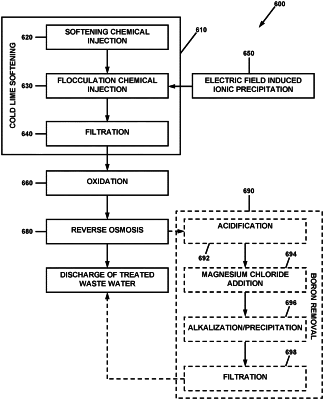|
1. A method for treating wastewater from an oil or gas well, the wastewater containing (a) suspended solids comprising at least one of a rock dust and a drilling mud, (b) residual water, and (c) organic contaminants including at least one of volatile organic compounds, oil or gas well drilling fluids, diesel oil, or natural crude oil, the method comprising: a) infusing a gas containing ozone into a stream of the wastewater, and causing oxidation and decomposition of the at least one of volatile organic compounds, oil or gas well drilling fluids, diesel oil, or natural crude oil in the stream of the wastewater to result in carbon dioxide, and water; b) adding aluminum chlorohydrate to the stream of the wastewater, and causing coagulation of the suspended solids to form suspended solids flocs in the stream of the wastewater, and causing coagulation of at least a portion of the residual water to form residual water flocs in the stream of the wastewater, wherein a concentration of the aluminum chlorohydrate in the stream of the wastewater is between about 0.001 to about 0.01 parts of the aluminum chlorohydrate per part of the wastewater; c) adding a flocculant to cause growth of the suspended solids flocs and growth of the residual water flocs to separable flocs entrained in the stream of the wastewater; d) delivering the stream of the wastewater through a filter medium of a filter, retaining the separable flocs on the filter medium of the filter, and discharging a clarified wastewater stream from the filter; e) causing precipitation of dissolved waste salts in the clarified wastewater stream, and separating precipitated waste salts from the clarified wastewater stream to produce a softened wastewater stream; f) delivering the softened wastewater stream to a first vessel, and injecting hydrogen peroxide solution and nano-sized bubbles of ozone into the softened wastewater in the first vessel to produce oxidized wastewater including residual ozone and trace residual organic matter in the first vessel; g) delivering a first oxidized wastewater stream from the first vessel to a carbon filter, causing decomposition of the residual ozone in the first oxidized wastewater stream, and separating the trace residual organic matter from the first oxidized wastewater stream to produce a second oxidized wastewater stream including remaining dissolved waste salts; and h) delivering the second oxidized wastewater stream to a first reverse osmosis membrane and causing reverse osmosis through the first reverse osmosis membrane, and separation of a first portion of the remaining dissolved waste salts from the second oxidized wastewater stream to produce a first permeate wastewater stream.
|
